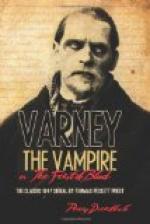“Yes; I found some pistols which I used to take with me on the continent, and she has them both well loaded, so that if the vampyre makes his appearance, he is likely to meet with rather a warm reception.”
“Good God! was it not dangerous?”
“Not at all, I think.”
“Well, you know best, certainly, of course. I hope the vampyre may come, and that we may have the pleasure, when we return, of finding him dead. By-the-bye, I—I—. Bless me, I have forgot to get the materials for lights, which I pledged myself to do.”
“How unfortunate.”
“Walk on slowly, while I run back and get them.”
“Oh, we are too far—”
“Hilloa!” cried a man at this moment, some distance in front of them.
“It is Mr. Chillingworth,” said Henry.
“Hilloa,” cried the worthy doctor again. “Is that you, my friend, Henry Bannerworth?”
“It is,” cried Henry.
Mr. Chillingworth now came up to them and said,—
“I was before my time, so rather than wait at the church porch, which would have exposed me to observation perhaps, I thought it better to walk on, and chance meeting with you.”
“You guessed we should come this way?’
“Yes, and so it turns out, really. It is unquestionably your most direct route to the church.”
“I think I will go back,” said Mr Marchdale.
“Back!” exclaimed the doctor; “what for?”
“I forgot the means of getting lights. We have candles, but no means of lighting them.”
“Make yourselves easy on that score,” said Mr. Chillingworth. “I am never without some chemical matches of my own manufacture, so that as you have the candles, that can be no bar to our going on a once.”
“That is fortunate,” said Henry.
“Very,” added Marchdale; “for it seems a mile’s hard walking for me, or at least half a mile from the hall. Let us now push on.”
They did push on, all four walking at a brisk pace. The church, although it belonged to the village, was not in it. On the contrary, it was situated at the end of a long lane, which was a mile nearly from the village, in the direction of the hall, therefore, in going to it from the hall, that amount of distance was saved, although it was always called and considered the village church.
It stood alone, with the exception of a glebe house and two cottages, that were occupied by persons who held situations about the sacred edifice, and who were supposed, being on the spot, to keep watch and ward over it.
It was an ancient building of the early English style of architecture, or rather Norman, with one of those antique, square, short towers, built of flint stones firmly embedded in cement, which, from time, had acquired almost the consistency of stone itself. There were numerous arched windows, partaking something of the more florid gothic style, although scarcely ornamental enough to be called such. The edifice stood in the centre of a grave-yard, which extended over a space of about half an acre, and altogether it was one of the prettiest and most rural old churches within many miles of the spot.




